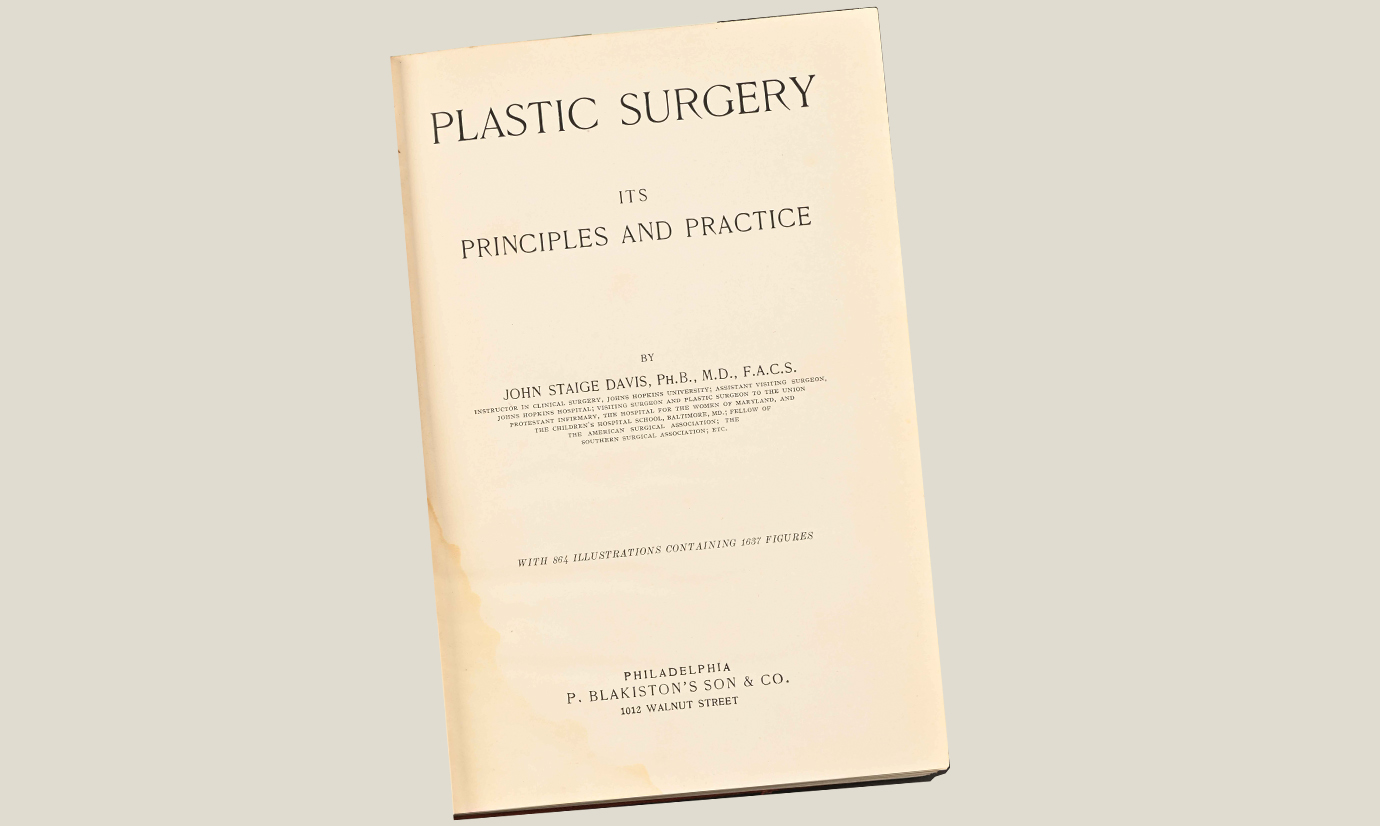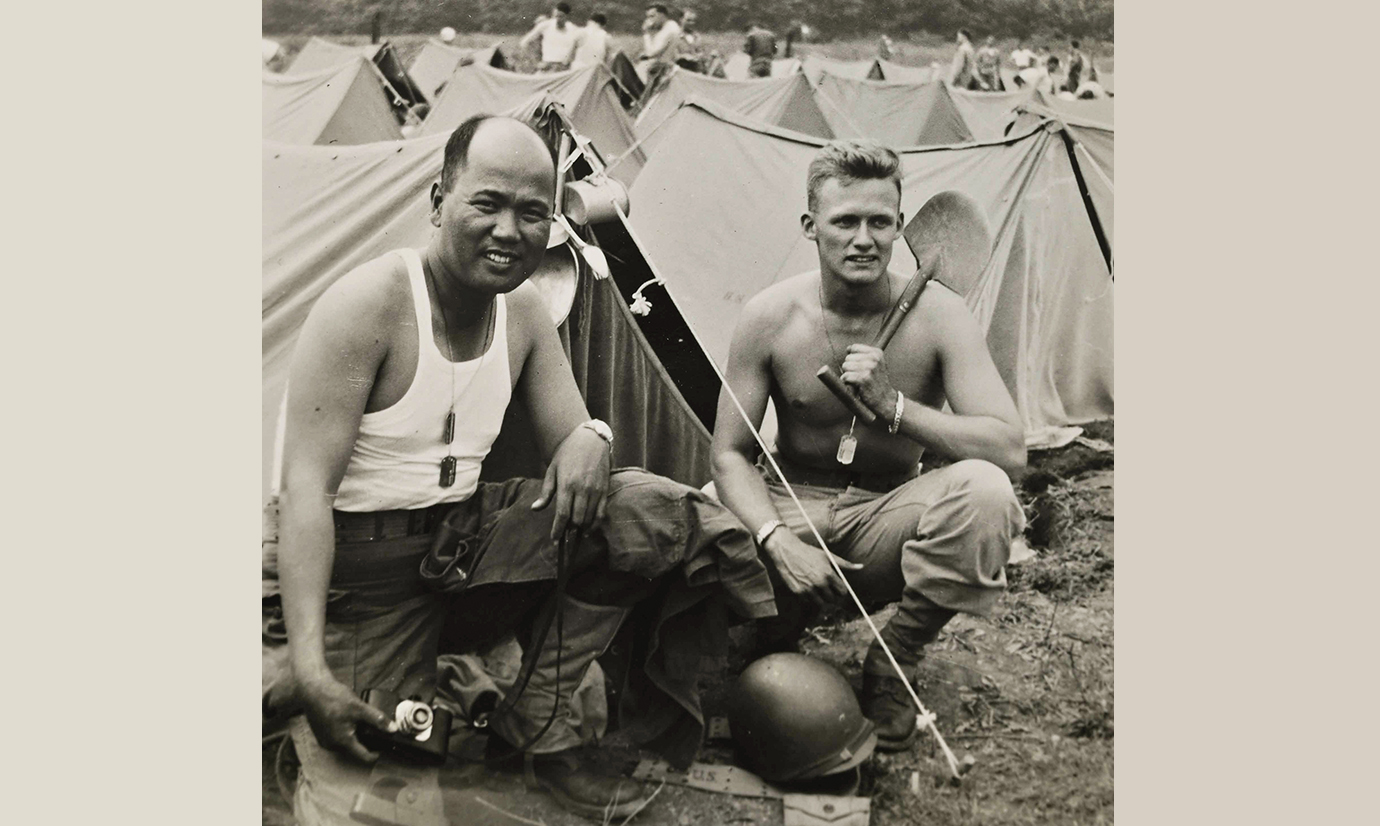An Uphill Climb
Excerpted from The Skin & Its Contents: The History of Plastic and Reconstructive Surgery, 2024, by Michael Anft

John Staige Davis intently focused on research that would provide the grist for four decades of vital and groundbreaking plastic surgery publications. Courtesy of Bowdoin Davis
It’s a history wrapped around a paradox: Johns Hopkins is, in many ways, the national birthplace of the specialty of plastic and reconstructive surgery. Yet it can be said with equal certainty that Johns Hopkins became so against the wishes of some of its most storied medical men.
Though The Johns Hopkins Hospital would birth a steady stream of plastic and reconstructive surgical breakthroughs from its 1889 founding and onward, its specialists would face several decades of indifference, and sometimes even disrespect, from several Johns Hopkins legends.
More than a century ago, when John Staige Davis published his groundbreaking text, Plastic Surgery: Its Principles and Practice, he sent copies with his compliments to three historical giants of Johns Hopkins Medicine: William Welch, William Halsted and Robert Williams. In the book’s preface, Davis — a school of medicine grad (1899) and both a visiting surgeon and instructor at Johns Hopkins at the time — thanked one of those giants, William Halsted, then the chief of surgery and perhaps the most venerated surgeon in the world.
A couple of years before that, Davis divulged his idea for a book on the specific techniques of plastic work and reconstruction. Halsted harrumphed a response. “He could see no use in doing it,” Davis wrote. “I decided to do it anyway and told him so.”
The book turned out to be the first of its kind in the U.S. — a comprehensive tome on plastic and reconstructive procedures that covered virtually every part of the body. And it was written by the first general surgeon in the nation to make such operations the sole focus of his practice. Yet, plastic surgery and the specialty it painstakingly depicted in 1919 were beneath the concerns of Davis’ Johns Hopkins elders, many of whom believed plastic and reconstructive work could be done by general surgeons. Specialization, for them, was fruitless.
Halsted had trained Davis in the developing arts of anesthetics, sterilization and modern surgery. But neither Halsted nor the others ever acknowledged receiving Davis’ all-encompassing primer on plastic surgery.
“When my book was published … I sent a copy to Dr. Welch, Dr. Halsted, and Dr. [Robert] Williams, among others, and these three only failed to acknowledge the receipt of the book,” Davis wrote. “I always wondered whether this inside group in the medical school were provoked because I had gone ahead with it in spite of Dr. Halsted’s opposition.”
Davis was forced to continue his fight for relevance within the Dome for 30 years, in search of, among other things, a full-fledged plastic surgery division. He would spend much of his time performing procedures within his private practice or at Union Memorial Hospital — and relatively few of them at Johns Hopkins.
“It has always been disappointing to me that having started the idea of plastic clinics in this country and written and advocated their establishment in all large hospitals and medical schools, that a better opportunity was not given me at the Johns Hopkins Hospital to develop and carry out my ideas in an ideal way,” Davis would write near the end of his career, in the 1940s.
Today, Johns Hopkins Plastic and Reconstructive Surgery, led by Richard J. Redett, is an acknowledged worldwide leader in a variety of related subfields, from microvascular surgery to the preservation and transplantation of several types of organs. The department features two dozen faculty members and receives more applications from prospective surgical residents than any other in the nation. It also garners the most federal funding among institutions that perform reconstructive procedures and conduct research.
Those early years — that long uphill climb into a gale — forced plastic surgery at Johns Hopkins to create its own brand of excellence and innovation. Its leaders worked tirelessly to develop a strong, efficient, expansive and path-making program — one that could sustain itself even while facing varying levels of disinterest from some leaders at the hospital and medical school.

Davis’ Plastic Surgery: Its Principles and Practice provides illustrated instruction on a series of best practices in treatment — including the uses of prosthesis, pedunculated flaps and skin grafts; tissue transplantation; cures of bladder blockages; and repairs for cleft palates, damaged ears and more.
‘The Skin and Its Contents’
Denied the opportunity early on to stand on the shoulders of Johns Hopkins giants, the hospital’s plastic surgery service continually minted titans of its own. Those surgeons saw the possibility to remake or reshape any part of the body that needed it, and painstakingly created the techniques and tools to do it.
One longtime general surgeon at Johns Hopkins jokingly observed more than a half-century ago that Milton Edgerton Jr., who ran the plastic surgery division from 1951 to 1970, limned the purview of plastic surgery as pretty much the entire human body: “the skin and its contents.”
Edgerton was drawn toward plastic surgery while serving as an Army officer at Valley Forge General Hospital from 1944-1947. The hospital’s small crew of surgeons performed 15,000 procedures on injured soldiers — handling hand reconstructions, facial surgeries and skin grafts on burn victims — without losing a single one.
“Edgerton was amazing,” says William Futrell, formerly a plastic surgery resident at The Johns Hopkins Hospital. “He was a giant. He had patients from all around the world for many things — head and neck cancer, aesthetic surgery. He was an expert on the details, and he was the best.”
Edgerton not only expanded the definition of the field but made understanding the psychology of patients both a clinical and research priority. How patients would feel about the results of a procedure became of paramount importance to him, the residents who learned under him, and his Johns Hopkins successors.
“The field of plastic surgery extends from the top of the head to the sole of the foot, and no properly trained plastic surgeon would be willing to limit his work to the face alone.”
John Staige Davis

Milton Edgerton Jr., right, developed extensive experience in reconstructive surgery during his Army tenure at Valley Forge General Hospital from 1944–1947.
His successor, John “Jack” Hoopes, spent much of his two decades at the helm (1970 to 1990), reconfiguring Johns Hopkins’ now-lauded residency program. Hoopes also expanded the division’s reach by creating partnerships with other hospitals and opening new outpatient services beyond the city limits.
One of those partnerships, with the University of Maryland’s R Adams Cowley Shock Trauma Center, gave Johns Hopkins plastic surgery residents — notably, Paul Manson —the grim opportunity to spend many long nights rebuilding faces ravaged by car accidents and other calamities. Manson would come to lead not only the Johns Hopkins plastic surgery division (1990 to 2010), but also surgeons across the nation in devising ways to improve craniofacial and neurosurgical plastic procedures immediately after trauma.
Edgerton, Hoopes, Manson and others in the division spearheaded a decades-long appeal to deans, hospital chiefs and general surgery chairpersons to become its own department — an administrative entity with control of its own operating rooms and purse strings.
That goal was achieved in 2010, nearly a century after John Staige Davis became the first general surgeon to specialize in the plastic surgery and reconstructive field, with the establishment in 2010 of the Department of Plastic and Reconstructive Surgery.
